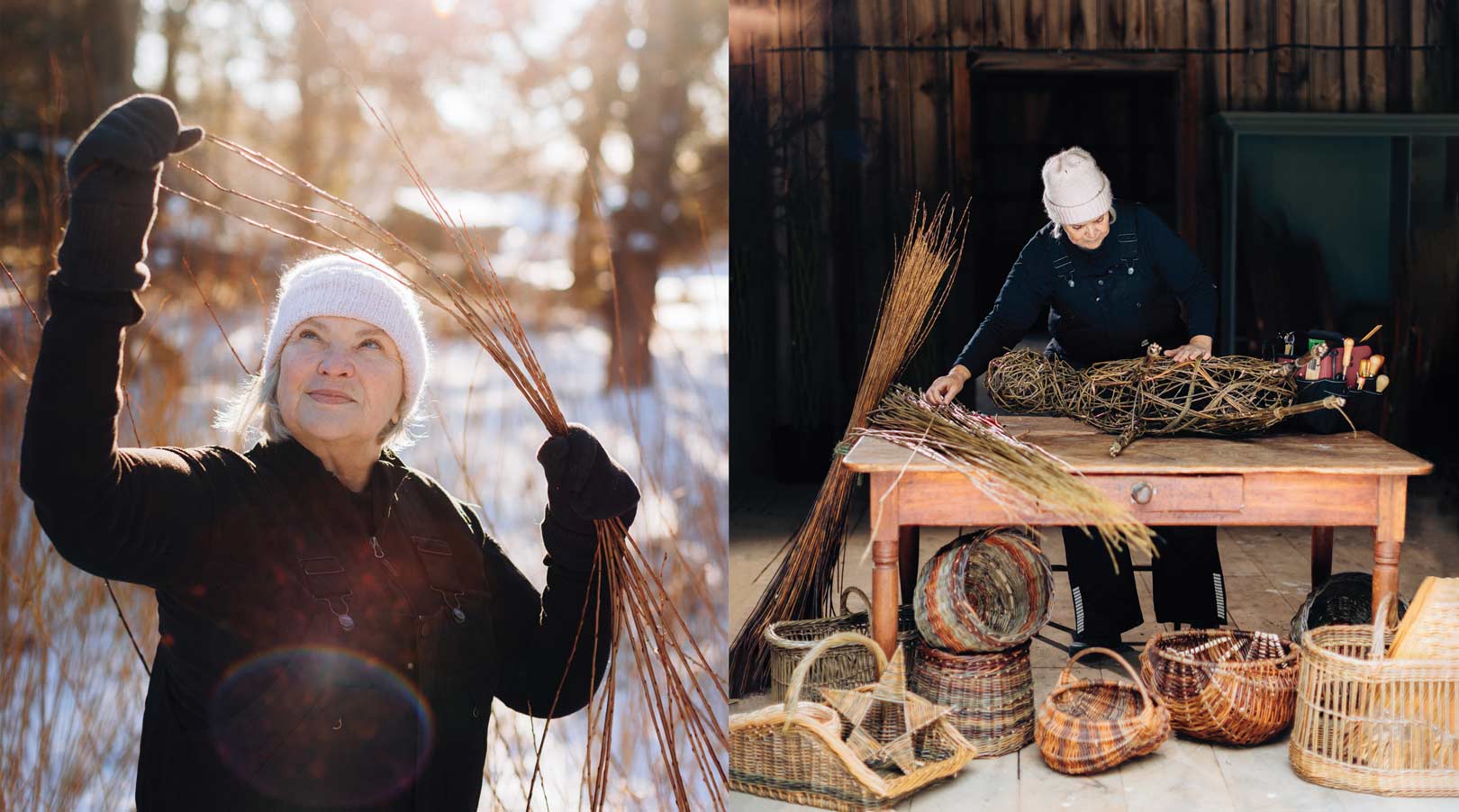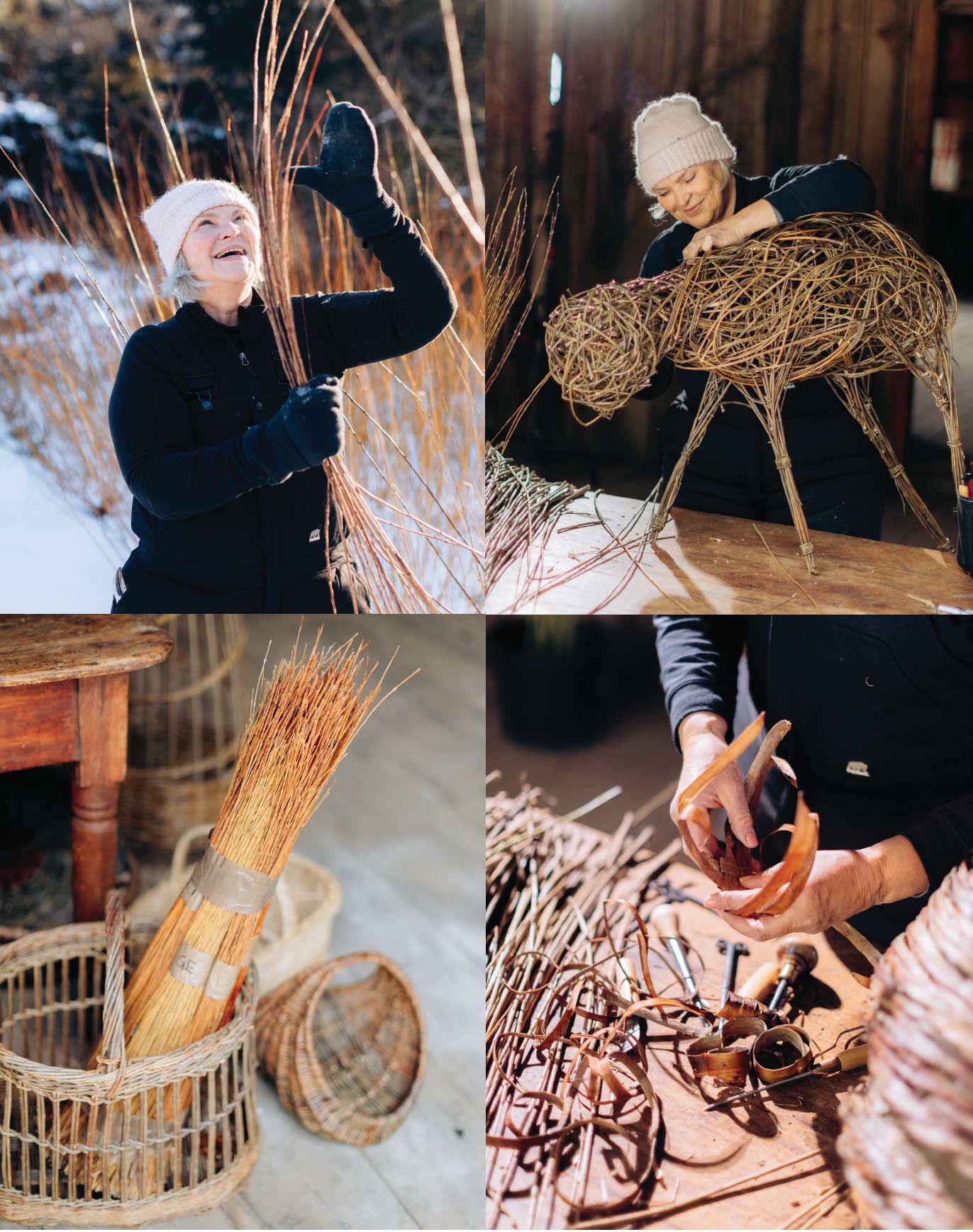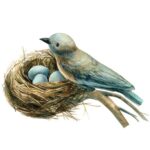

When it comes to weaving, willow has always been the material of choice. Strong and flexible, the hardy plant was woven into containers that carried fish, dairy products, stones and coal. It was made into lobster traps, shelters, livestock gates – and was even used to make caskets. Now it’s growing in popularity again, but this time among artists and environmental experts, who are using willow to mitigate the effects of climate change.
Sian Pritchard, a horticulturalist trained at the University of Guelph, began growing willow varieties about 10 years ago. She now cultivates more than 30 varieties of willow (Salix) species on her appropriately named farm, Wind and the Willow, in Grafton. “Willow is carbon neutral. I can grow it, process it and harvest it, without any carbon emissions. It grows in poor soil, propagates easily and it grows fast,” explains Sian.
“I was hooked! The material, the process, the product, the learning and the community – it’s so fulfilling.” SIAN PRITCHARD
She was introduced to the many functions of willow while visiting her uncle in North Wales.
“My uncle lives in a small village in Conwy Valley. When he first purchased the house, his back garden was separated from a neighbouring farmer’s field by a low stone wall. The sheep on the other side of that stone border often ventured across it to inspect my uncle’s perennial garden, so in an effort to keep them out, he commissioned a local weaver to create some willow hurdles that could be mounted on that not-so-effective stone fence. They were such a beautiful solution! They were artistic, natural and effective.” Sian then took a willow weaving course with renowned Canadian basketry artist Ankaret Dean, known among weavers as the pioneer of modern willow basketry, and took to it right away.
“I was hooked!” she exclaims. “The material, the process, the product, the learning and the community – it’s so fulfilling. I had volunteered to help Ankaret on a commission to do willow sculptures of the Cirque du Soleil acrobats in Oakville Place’s food court atrium. That initial experience of sculpting willow was thrilling!”
With a full-time landscape design business and young family on the go, Sian didn’t pursue basketry until years later. She continued to work on large-scale weaving projects with her friend and teacher Mel Bastier of South Wales, who helped hone her skills. She still keeps in touch with Ankaret Dean, who at 91 years of age continues to teach weaving and gives talks about willow’s many applications.
“The community is very tight knit, we all share techniques,” comments Sian. “I look for every opportunity I can to learn from the masters in each field, and that takes me to the UK at least once a year. Fortunately, many teachers will travel to Canada, so I’ve been able to learn from French, Danish, English, Welsh and American makers as well as from some excellent teachers here in Canada. I feel it’s my responsibility to keep learning so I can be a better teacher.”
Sian wanders through 10-foot-high soaring willow plants, where small birds are perched and swaying on the branches and the multicoloured waist-high “rods” she will use for weaving and structural installations. “Willow grows from March to November, and then the tree becomes dormant and drops its foliage, and I can harvest it,” Sian explains. “I cut the plants down, leaving about an inch or a bit more, then I sort, bundle, and dry them.”
Once the willow rods have completely dried, she then has to soak them in water for days (and sometimes a week depending on their size and variety) and then “mellow” them (take them out of the water and place them under towels), before they are malleable enough to be woven without breaking. The end result is a colourful array of patterned baskets in various-sized weaves, sturdy garden obelisks and trellises, intricate ornaments and even woven living willow trees.
Meanwhile, the plant that has been cut down in the harvest overwinters in the field.
Sian explains: “In spring, the base plant puts out more shoots, usually two to three for each rod that was cut, so from one small cutting, the plant will generate many more weavers.”
Sian’s enthusiasm over the many uses of willow is echoed by environmentalists and horticultural groups. Willow’s ability to withstand Canadian winters as well as its rapid growth is used by city planners as an easy way to create windbreaks and prevent soil erosion around rivers and waterways. The plant also has the capacity to replenish nutrients in poor soils, and in some cases it can even regenerate soils in industrial areas contaminated by industrial and agricultural operations.
Willow is also being considered as a biomass (fuel) crop. Woody varieties are grown into larger rods, harvested and then processed into wood pellets. Because willow thrives in areas not suitable for other crops, grows quickly and costs relatively little to maintain, farmers can supplement their income and grow biomass without impacting the environment. As the discussion of biomass, soil rehabilitation and erosion prevention evolves, Sian Pritchard says that while she is in tune with the environmental benefits, it’s willow’s versatility in the pursuit of art that fuels her passion.
“Working with willow blends art and horticulture into something imaginative, meaningful and sustainable.”
Story by:
Micol Marotti
Photography by:
Mira Knott




